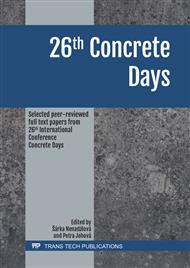p.114
p.120
p.126
p.132
p.140
p.149
p.157
p.163
p.169
Experimental Investigation of Bond between GFRP Reinforcement and Concrete
Abstract:
The reinforcing steel embedded in concrete is generally protected against corrosion by the high alkalinity (pH = 12.5 to 13.5) of the concrete pore solution. The structural degradation of concrete structures due to reinforcement’s corrosion has an impact on the safety, serviceability and durability of the structure. The corrosion of reinforcements in the construction of a transport infrastructure (especially bridges), parking areas, etc., is primarily initiated by chlorides from de-icing salts. Glass fiber reinforcement polymer (GFRP) bars are suitable alternatives to steel bars in reinforced concrete applications. The bond between concrete and reinforcement is one of the basic requirements for the composite action of both materials. The transfer of forces between the steel reinforcement and the concrete is provided by the following mechanisms: adhesion, friction and mechanical interlocking. The bond between GFRP reinforcement and concrete is different and it is ensured by friction and mechanical interlocking of the rebar surface. The chemical bond does not originate between GFRP reinforcement and the surrounding concrete, so adhesion does not contribute to transfer of the bond forces. Some few test methods are used to determine the bond between GFRP reinforcement and concrete. The pull-out tests were used to determine the bond behavior between GFRP rebars and concrete. This paper describes the preparation, process, results and evaluation of the pull-out tests.
Info:
Periodical:
Pages:
140-145
Citation:
Online since:
August 2020
Authors:
Price:
Сopyright:
© 2020 Trans Tech Publications Ltd. All Rights Reserved
Share:
Citation:


